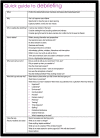Dealing with complications in interventional radiology
- PMID: 38512496
- PMCID: PMC10957835
- DOI: 10.1186/s42155-024-00442-w
Dealing with complications in interventional radiology
Abstract
It is widely accepted that most misadventures, which lead to harm have not occurred because of a single individual but rather due to a failure of process that results in healthcare workers making mistakes. This failure of process and the pervasiveness of adverse events is just as prevalent in Interventional Radiology (IR) as it is in other specialities. The true prevalence and prevailing aetiology of complications in IR are not exactly known as there is a paucity of investigative literature into this area; especially when compared with other more established disciplines such as Surgery. Some IR procedures have a higher risk profile than others. However, published data suggests that many adverse events in IR are preventable (55-84%) and frequently involve a device related complication such as improper usage or malfunction. This article aims to discuss factors that contribute to complications in IR along with tools and strategies for dealing with them to achieve optimal patient outcomes.
© 2024. The Author(s).
Conflict of interest statement
None.
Figures







References
-
- Kohn LT, Corrigan JM, Donaldson MS, editors. Institute of Medicine (US) Committee on Quality of Health Care in America. To err is human: building a safer health system. editors. Washington (DC): National Academies Press (US); 2000. PMID: 25077248. - PubMed
-
- Ahsani-Estahbanati E, Sergeevich GV, Doshmangir L. Interventions to reduce the incidence of medical error and its financial burden in health care systems: a systematic review of systematic reviews. Front Med 2022;9. https://www.frontiersin.org/articles/10.3389/fmed.2022.875426. - DOI - PMC - PubMed
-
- World Health Organization . Fundamentals in patient safety: what is patient safety? Geneva: World Health Organization; 2013.
Publication types
LinkOut - more resources
Full Text Sources
